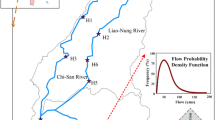Abstract
This paper presents a new methodology for the sustainable and optimal allocation of water for a river basin management area. The model distinguishes between short and long-term planning horizons and goals using a short-term modeling component (STM) and a long term modeling component (LTM) respectively. An STM is a linear programming problem, and optimizes a monthly allocation schedule on an annual basis in terms of maximum net economic benefit. A cost of depletion is included in the STM net benefit calculation to address the non-use value of groundwater. An LTM consists of an STM for every year of the long-term planning horizon. Each LTM is quantified using a sustainability index, with sustainability defined in terms of risk to supply and ecological, environmental, and hydrological integrity. The LTMs are optimized to determine the most sustainable net economic benefit for the management area using a genetic algorithm. The model is applied to a test case representative of a management area in Arizona in order to highlight its potential utility.








Similar content being viewed by others
References
Alcamo J, FlöRke M, MäRker M (2007) Future long-term changes in global water resources driven by socio-economic and climatic changes. Hydrol Sci J 52(2):247–275
Arthington AH, Bunn SE, Poff NL, Naiman RJ (2006) The challenge of providing environmental flow rules to sustain river ecosystems. Ecological App 16(4):1311–1318
Aydin AY, Mays LW, Schmitt T (2014) Technical and environmental sustainability assessment of water distribution systems. Water Resour Manag. doi:10.1007/s11269-014-0768-y
Cai X (1999) A modeling framework for sustainable water resources management. Doc, University of Texas at Austin, Austin
Cai X, McKinney DC, Lasdon LS (2001) Solving nonlinear water management models using a combined genetic algorithm and linear programming approach. Adv Water Resour 24(6):667–676
Cai X, McKinney DC, Lasdon LS (2003) Integrated hydrologic-agronomic-economic model for river basin management. J Water Resour Plan Manag 129(1):4
GAMS Development Corporation (n.d.) GAMS - General algebraic modeling system
Gleick PH (2000) A look at twenty-first century water resources development. Water Int 25(1):127–138
Hotelling H (1931) The economics of exhaustible resources. J Polit Econ 39(2):137
Kuhlman T, Farrington J (2010) What is sustainability? Sustainability 2(11):3436–3448
Lant C (2007) Water resources sustainability: an ecological-economics perspective. Water resources sustainability, Mays LW ed, McGraw-Hill ; WEF Press, New York : Alexandria, Va
Loucks DP (1997) Quantifying trends in system sustainability. Hydrol Sci J 42(4):513–530
Loucks DP, Gladwell JS (1999) International hydrological programme, and Unesco/IHP-IV project M-4.3. Sustainablity criteria for water resource systems. Cambridge University Press, New York
Mays LW (ed) (2007) Water resources sustainability. McGraw-Hill ; WEF Press, New York
Mays LW (2013) Groundwater resources sustainability: past, present, and future. Water Resour Manag 27(13):4409–4424
MySQL : MySQL 5.6 Reference manual: 1.3.1 What is MySQL? (n.d.) <http://dev.mysql.com/doc/refman/5.6/en/what-is-mysql.html>
Oxley RL (2015) Ecological, environmental and hydrological integrity in sustainable water resource management for river basins. Doctoral Dissertation, Arizona State University
Pearce DW, Turner RK (1990) Economics of natural resources and the environment. Johns Hopkins University Press, Baltimore
Pillo G, Palagi L (2002) Nonlinear programming. In: Pardalos PM, Resende MGC (eds) Handbook of applied optimization. Oxford University Press, New York
Poff NL (2009) Managing for variability to sustain freshwater ecosystems. J Water Resour Plan Manag 135(1):1
Poff NL, Allan JD, Bain MB, Karr JR, Prestegaard KL, Richter BD, Sparks RE, Stromberg JC (1997) The natural flow regime. Bioscience 47(11):769
Pool DR, Blasch KW, Callegary JB, Leake SA, Graser LF (2011) Regional groundwater-flow model of the Redwall-Muav, Coconino, and alluvial basin aquifer systems of northern and central Arizona: U.S. Geological Survey
Rijsberman FR (2006) Water scarcity: fact or fiction? Agric Water Manag 80(1–3):5–22
Rosegrant MW, Cai X, Cline SA, International Food Policy Research Institute., and International Water Management Institute (2002) Global water outlook to 2025 averting an impending crisis. International Food Policy Research Institute, Washington
Rothman DW (2007) Evaluation of water resources sustainability using a multi-objective genetic algorithm. Doctoral Dissertation, Arizona State University
Rothman DW, Mays LW (2013) Water resources sustainability: development of a multi-objective optimization model. J Water Resources Planning Manag, 131126205031004
Rubin P (2010) OR in an OB world: piecewise-linear functions in math programs. <http://orinanobworld.blogspot.com/2010/10/piecewise-linear-functions-in-math.html>
Sandoval-Solis S, McKinney DC, Loucks DP (2011) Sustainability index for water resources planning and management. J Water Resour Plan Manag 137(5):381
Solow RM (1993) Sustainability: an economist’s perspective. In: Dorfman R, Dorfman N (eds) Economics of the environment: selected readings. Norton and Company, New York, pp 179–187
Unver O (2007) Water-based sustainable integrated regional development. In: Mays LW (ed) Water resources sustainability. McGraw-Hill ; WEF Press, New York
Vorosmarty CJ (2000) Global water resources: vulnerability from climate change and population growth. Science 289(5477):284–288
World Commission on Environment and Development (1987) Our common future. Oxford University Press, Oxford
Author information
Authors and Affiliations
Corresponding author
Rights and permissions
About this article
Cite this article
Oxley, R.L., Mays, L.W. & Murray, A. Optimization Model for the Sustainable Water Resource Management of River Basins. Water Resour Manage 30, 3247–3264 (2016). https://doi.org/10.1007/s11269-016-1345-3
Received:
Accepted:
Published:
Issue Date:
DOI: https://doi.org/10.1007/s11269-016-1345-3




